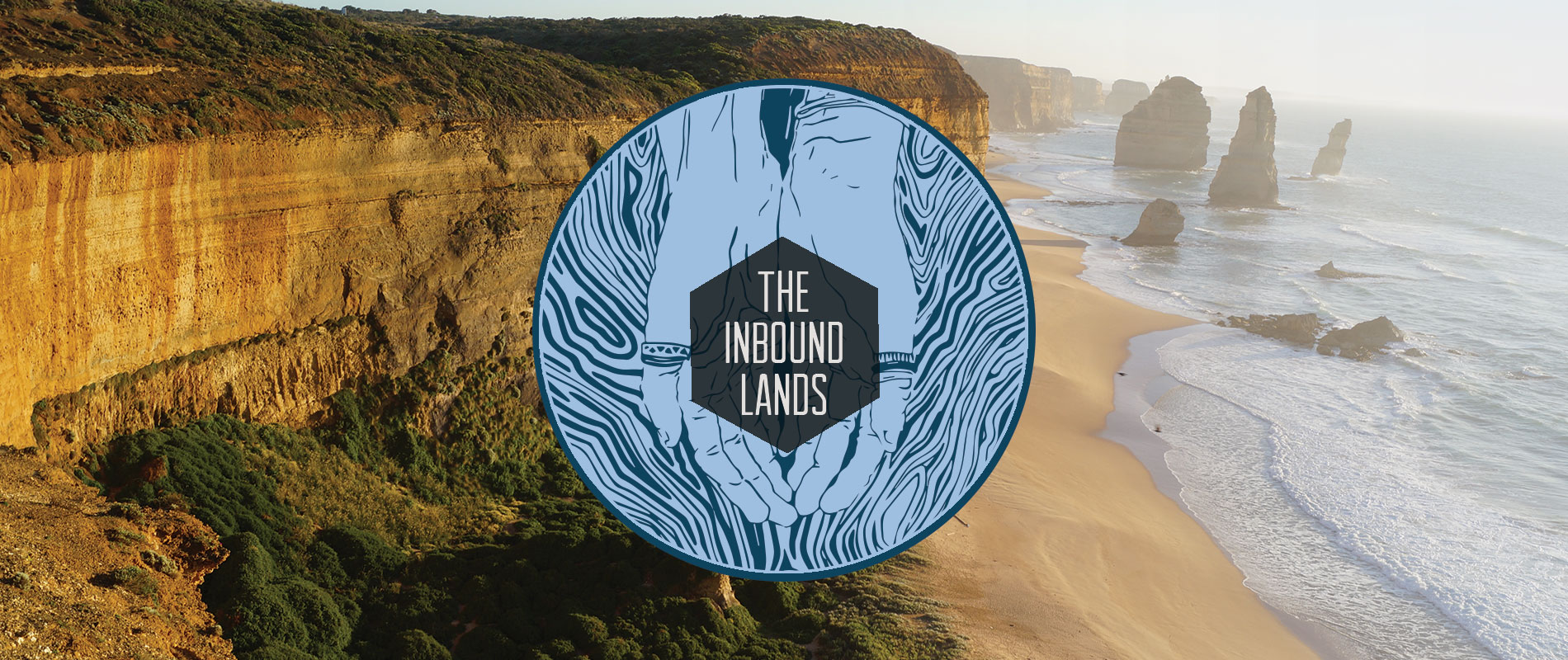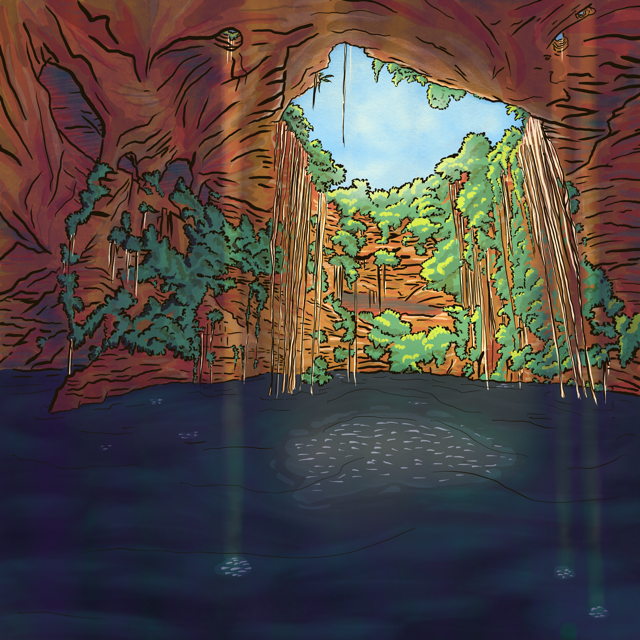Tsenote Cakatohn
[seh-NOH-teh sah-kah-TOHN]
Tsenote Cakatohn is a series of tsenote located in the high coastlands in Ochi Maninhka.
Though the territory is predominantly Birdfolk, native groups of Southern Walkingfolk are present in the area. These peoples contain a rich and vibrant mythology around Cakatohn, which they believe is a gateway for the dead to be able to cross over into life, should they complete the series of trials necessary for rebirth; the process is a story told to explain the wisdom of young people who are said to be "old souls."
It is the mythological trail that allowed scientists to piece together the geographical history of Cakatohn, and to uncover the geological processes that create this unique area of tsenote.
Geography
As part of a larger opehni to'ce, Cakatohn extends through several massive open tsenote sites, as well as includes several travertine-capped depressions believed to be part of the same system.
Unique features of Cakatohn within the greater Inbound Lands
Unique within the southern regions of The Inbound Lands, Cakatohn is believed to have been created by groundwater, diverted by the rise of the landscape through the Eje. The unique placement created a hot water basin, where groundwater following into the area is turned acidic by rising thermal energy and volcanic gasses, dissolving the limestone. As the porous stone collapsed, it created large bore holes underground that eventually broke to the surface. Over time, the same acidic water has contributed to travertine deposits that ring (and in some cases, cap) the mouths, their growth catalyzed by the unique hotwater wahu'stsa^zhingaoni. present in their bores. Other southern tsenotes are believed to have been formed through similar erosions of limestone due to other processes, but the uniquely volcanic area of Cakatohn makes it a distinctive habitat. Within the greater Inbound Lands, similar active thermal karst systems are located in amid the Hotlands of the North Reach, and extinct (capped) systems are known among the Trifold Peaks area.Features included within Cakatohn
Over time, studies of the area of Cakatohn have come to include the following land features, arranged via their mythological order, which progresses geographically from the southern most to the northernmost tip:- Sto'we^in – The most southward, Sto-we^in, or "Flowing Rock," is a powerful spring that rushes deep blue water from the limestone cliffs into staggered, colorful travertine stairs. Within the waterfall is a large underwater cave, known for its impressive travertine formations. Though it is easily connected to Cakatohn by the similarity in biomats and travertine, Sto'we^in was originally also connected to Cakatohn by myth: in the journey of the undead, those who are deemed unworthy are passed to Sto'we^in instead, where they rejoin the earth as colorful waters, to nourish the future in other ways.
- Hke'e Oshtse – A powerful spring, "Turtle Remains" is an above-ground, long pool noted not only for its beautifully colorful biomats and travertine shelves, but for its connection to Cakatohn proper through an underground, underwater passage narrowed by travertine deposits. As a discharge for Cakatohn's water system, it is the most common entrance into Cakatohn, at least during the drier months of Zhan'hcuk^a and Ethe'zeh. During the wetter months of Hpa'ta and Cexeni', the current is so strong as to be nearly impassable and highly dangerous to swimmers. Hke'e Oshtse is the start of the journey for the dead: those who mourn the dead must pray by the waters for the rebirth of their loved ones spirit, and empty bowls of water carried from Alameta into the current. If the spirit is judged by the turtles who live there and is deemed worthy of rebirth, they will invite the dead to pass the first challenge: of swimming upcurrent to be birthed out of Cakatohn. Cakatohn's extreme depth is believed to be a result of the breach into Hke'e Oshtse, allowing the current to carry away mineral and sediment that otherwise might clog the bore.
- Cakatohn – The namesake of the region, Cakatohn carries weight not only for its impressive depth - one of the deepest bores in the Inbound Lands - but also for its unique "floating islands," massive diameter, colorful biomats, and its mythical weight: if deemed worthy to be reborn, spirits that arise from Cakatohn begin an arduous journey towards rebirth. The vertical cliffs of Cakatohn make entry from the surface difficult, and the warm waters are acidic in nature due to the geothermals and volcanic gasses, but the combination create the unique floating islands found here: the travertine circles, ranging from 9 feet to 30 feet in diameter, are covered in gentle meadors of Cakate grasses, and move delicately in the breezes across the surface of the water. As the spirits prepare to undertake their journey, they are said to wait here on the grasses before making the climb above.
- Karako – A narrow, deep bore with sloping sides, Karako is filled with colorful water reflecting the many patterns of wahu'stsa^zhingaoni who live within its acidic, sulfurous waters. Partially capped by travertine, Karako's relatively small opening leads to a much larger underchamber with warm water, evidencing the geothermal energy below. In the mythical journey of the dead, Karako becomes a vital stop: because they are newly released, the dead do not have clothes, and must descend to the waters to convince the colorful biomats of wahu'stsa^zhingaoni to lend them spiritual robes for their journey; the color that they are given is an indicator of the life they will lead should their journey of rebirth be successful. However, the walls of Karako are dangerous and brittle: the dead must choose their words wisely - to be persuasive enough to gather what is needed, but modest enough to turn away unnecessary gifts - or the weight of luxury is said to cause the walls to slide whenever they try to climb out.
- Bithe – With a lower water level than the surrounding tsenotes, Bithe is the coldest of the tsenotes in the Cakatohn area, with the exception of a significantly warmer underwater spring flowing into it, known as the Blood, which is closer in temperature to the nearby tsenotes. Unlike its neighbors, Bithe's water temperature varies seasonally, suggesting that it is largely cut off from the geothermals that feed the others, and the water itself lacks the acidity of the other tsenotes in the area, suggesting it is primarily fed by groundwater. The colder waters of Bithe are where the spirits are said to dip sticks, which are bundled and carried, as the bones for the future body they will inhabit.
- Pilita – Surrounded by a gentle meadow within the depression, the narrow mouth of Pilita - little more than a well opening - brings the surface of the water to the meadow, butextends through a deep bore before opening into a much broader underwater cave. It is expected that Pilita may fully cover itself with the growing travertine, and more than any other site, it has a protected status: pilgrims to the area have been known to chip away at the stone in efforts to stop Pilita from closing. In the mythos of the journey, the hot waters of Pilita are said to give breath to the spirits, who gather it from the morning fog and which they may carry in a bag until they have lungs.
- Azhup^roza – A unique feature known for its "double lid," Azhup^roza seems a wide and shallow pool at first glance, filled with sulfurous, bubbling water, milky white in appearance and hot to the touch. However, further study finds that the gas is escaping from minute cracks on the flat bottom, revealing a second lid made of travertine. The discovery of the second lid has led to the identification of the other, capped depressions as part of the overall Cakatohn system. Though the water itself has a rotten odor and tendency to tarnish metals dipped into the water, Azhup^roza is known for the area Akatse' trees, whose extract, leaves, and seeds have medicinal properties. Spirits of the dead must harvest Akatse' from Azhup^rosa in order to leave behind the ills of their past, mixing the tonic with the sulphuric waters of the tsenote to form a tea.
- Krishtalina – Located just at the rim of Azhup^roza lies Krishtalina, a high-walled, deep cave filled with cold blue water. Though divers have tried, the bottom narrows out into a series of impassable chokes. Small stone "rafts" can be seen floating on its surface. It is believed that water from Krishtalina may be feeding Azhup^roza, and is fed by discharge from the nearby Xonto'ce Caverns. In the journey of the dead, the dead must visit Krishtalina after drinking the tea of Azhup^rosa, and use its clear blue waters to cleanse their palate.
- Xonto'ce Caverns – "Broken Throat Caverns" is an extensive dry cave system notable for the many "broken," or collapsed, sections of ceilings. Over time, these open patches of Xonto'ce have filled with enormous fig trees, creating a verdant underground jungle home to a vibrant bat population. In the journey of the dead, Xonto'ce is a dangerous place: the dead must travel through the fig trees without eating from them, lest the seeds they swallow burst within their bellies and root them into the ground, unable to continue.
- Zeka – A dry sinkhole depression, Zeka is known for its unique floating lid! The travertine lid of this tsenote, meters deep, is detached from the bore itself, and moves gently on the surface of an unseen, underground lake. Combined with the discoveries of Azhup^roza, the lid of Zeka confirmed theories that the travertine was a growth process that would eventually seal tsenotes, and experts believe that if left to its own devices, Zeka may one day stop its gentle spin. Covered with Cakate grasses, those who walk upon it hear a gentle, hollow sound. In the mythos of the journey, the dead may pause here and hear the sounds of their names echoed again, and be satiated.
- Palumita – A smaller sinkhole, Palumita is a narrow bore hole entering into the ground. The grassy area around Palumita has traditionally been marked with strings of flags (which serve practical purposes of keeping folk from falling in). The spirits are said to collect the grasses to spin into skin, but the threads of the flags are provided in the belief that the colorful threads, collected as the fabric weathers and falls apart, will lend color to their new bodies.
- Tule – Tule is predominantly a large, dry depression, connected to Cakatohn first through the mythological journey of the dead, but later through the realization that the travertine was an ancient lid covering a hidden tsenote. When rains come, the tsenote fills with a temporary basin of water, earning it a place on the journey where the dead must pause to wait for the rains to fill Tule, and in doing so, gain the wisdom of patience before continuing on the way. Those who stomp on the bottom of Tule can hear the hollow sound similar to Zeka, which, as the spirits pace it waiting for rain, is said to create the rhythm of the heartbeat in their future body. When filled with water, Tule is the largest in diameter of all the tsenotes.
- Xarahpata – A dry sinkhole covered in dense, thorny vegetation, Xarahpata is connected to Cakatohn through myth: the bottom is full of Akatse' trees, whose blooms must be collected and carried to Owe'to'ce, given in exchange for the green water. Later research, after the discoveries at Azhup^roza, suggest that the bottom is possibly a dense travertine lid with waterbody underneath.
- Athik^o^Ixuana – "Lizard Under Earth" is a large cave system with two openings: a wider mouth with a large, tongue-shaped boulder, which leads through twisting passages lined with travertine flows into a larger cave marked with the second opening: a collapsed ceiling creating a large skylight, known as the Parietal. Named for the light-sensitive scale on the Ixuana Lizard which signals night and day, the large skylight provides the minor vegetation in the room with adequate light. Though Athik^o^Ixuana is not part of the journey of the dead per se, the cave itself represents a lizard who serves as a rain god impartially observing the journey, with the flows of travertine representing the water of time flowing from his jaws.
- Owe'to'ce – A tsenote known for its emerald-colored lake, Owe'to'ce, "Vegetal Throat," is characterized by steep sides with thorny vegetation, and whose lake is fed partially from surface water. The difficulty in reaching the water plays its role in the mythos: the rich emerald color of the water is said to be the lifeblood of plants, stolen from the drier Amaliyo; to progress on their journey of rebirth, the dead must carry it to the next tsenote. They may only collect the water after exchanging Akatse' blossoms, whose lifeforce will replace the borrowed waters.
- Amaliyo – Little is known about the challenging Amaliyo, whose narrow, steep mouth is partially covered by a travertine ring choked with vegetation, roots as thick as limbs, and the bones of those who have been caught in its grip. In Southern Walkingfolk legend, Amaliyo is an exit for the hungry dead, whose spiritual bodies climb in and out of the tangle with ease, and who prey on both the living and the righteous dead seeking rebirth. On the journey of the dead, the dead must pay their respects to Amaliyo by pouring water from Kolohata into it in order to nourish the roots, but if they are not pure in their intentions for rebirth, they will be drug below by and turned into the hungry dead. In respects to these legends (and for practical purposes of marking the entrance for the unwary), a line of staubs encircles the area, their posts hung with reflective decorations to confuse the eyes of the dead, and surrounded with offerings to appease them so they will climb back down. Out of respect for local beliefs, further research into Amaliyo has not been pursued.
- Edaskhosa – A small, muddy, rounded pool, Edaskhosa is fed by local springs. The concentration of acidic groundwater has made it popular in local legend: dead rising from Amaliyo are said to wish to travel to bathe away their past lives in Edaskhosa, after completing trials at other tsenotes.
- Alameta – A wide sinkhole characterized by the series of small springs that feed it, Alameta boasts tall, sloping cliff walls before the dive into crystalline waters. Because of the shift in winds and rains, Alameta receives boosts in water levels during the months of Manzhanwaleze from runoff in the area, and has variable water temperatures based on seasonality. The sloping walls of Alameta provide it with a beautiful sunrise: as the Northernmost and final point on the journey to rebirth, it is said that the dead must swim in its waters as the sun rises in order to complete the journey; in doing so, they may be born anew but as changed beings, better for having overcome the trials and now bringing that wisdom to their new life.
Outbound Significance
Artifacts referencing Tsenote Cakatohn include: Influence for Tsenote Cakatohn includes:- Estudios de Profundidad del Sistema Zacaton, by Marcus Gary (graduate student), Department of Geological Sciences, Jackson School of Geosciences, University of Texas at Austin
- Zacaton, A History, by Ann Kristovich
- Volcanic karstification of Sistema Zacaton, Mexico, (Gary, Sharp), for the Geological Society of America
- Karst Hydrogeology and Speleogenesis of Sistema Zacatón, (Gary), in the Association of Mexican Cave Studies bulletin 21, 2010
- Sistema Zacaton, Wondermondo
- Staubs and Ditchwater: A Friendly and Useful Introduction to Hillfolks' Hoodoo, by H. Byron Ballard
Alternative Name(s)
The name "Cakatohn" is a nonsense word, suggesting its ancient origin as a borrow word; among Southern Walkingfolk, the site is sometimes referred to as Zacaton.
Type
Cave System
Owning Organization






Comments